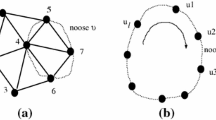Abstract
We propose a new optimization approach based on DC (Difference of Convex functions) programming and DCA (DC Algorithm) to the so-called Minimum M-Dominating Set problem in graphs. This problem is beforehand re-casted as a polyhedral DC program with the help of exact penalty in DC programming. The related DCA is original and computer efficient because it consists of solving a few linear programs and converges after a finite number of iterations to an integer solution while working in a continuous domain. Numerical simulations show the efficiency and robustness of DCA and its superiority with respect to standard methods.
Similar content being viewed by others
References
Basagni S, Mastrogiovanni M, Panconesi A, Petrioli C (2006) Localized protocols for ad hoc clustering and backbone formation: A performance comparison. IEEE Trans Parallel Distrib Syst 17(4):292–306
Brešar B, Henning MA, Rall DF (2008) Rainbow domination in graphs. Taiwan J Math 12:213–225
Dai D, Yu C (2009) A 5+ϵ-approximation algorithm for minimum weighted dominating set in unit disk graph. Theor Comput Sci 410:756–765
Dai F, Wu J (2004) An extended localized algorithm for connected dominating set formation in ad hoc wireless networks. IEEE Trans Parallel Distrib Syst 15(10):908–920
Dutot A, Guinand F, Olivier D, Pigné Y (2007) Graphstream: A tool for bridging the gap between complex systems and dynamic graphs. In: EPNACS: Emergent properties in natural and artificial complex systems
Erdős P, Rényi A (1959) On random graphs. Publ Math 6:290–297
Fomin FV, Kratsch D, Woeginger GJ (2005) Exact (exponential) algorithms for the dominating set problem. In: Graph-theoretic concepts in computer science. Lecture notes in computer science, vol 3353. Springer, Berlin, pp 245–256
Garey M, Johnson DS (1990) Computers and intractability; A guide to the theory of NP-completeness. Freeman, San Francisco
Gaspers S, Kratsch D, Liedloff M (2006) Exponential time algorithms for the minimum dominating set problem. In: Proceedings of SWAT, vol 4059, pp 148–159
Guha S, Khuller S (1998) Approximation algorithms for connected dominating sets. Algorithmica 20(4):374–387
Harary F, Haynes TW (2000) Double domination in graphs. Ars Comb 50:201–213
Hedetniemi ST, Laskar RC (1990) Bibliography on domination in graphs and some basic definitions of domination parameters. Discrete Math 86(1–3):257–277
Khamis SM, Daoud SS, Essa HAE (2009) A randomized algorithm for determining dominating set in graphs of maximum degree five. Theor Comput Sci 410:5122–5127
Le Thi HA, Pham Dinh T (1997) Solving a class of linearly constrained indefinite quadratic problems by DC algorithms. J Glob Optim 11(3):253–285
Le Thi HA, Pham Dinh T (2003) Large scale molecular optimization from distances matrices by a dc optimization approach. SIAM J Optim 14(1):77–116
Le Thi HA, Pham Dihn T (2005) The dc (difference of convex functions) programming and DCA revisited with DC models of real world nonconvex optimization problems. Ann Oper Res 133(1–4):23–46
Le Thi HA, Pham Dinh T, Le Dung M (1999) Exact penalty in DC programming. Vietnam J Math 27(2):169–178
Liao CS, Chang GJ (2003) k-tuple domination in graphs. Inf Process Lett 87(1):45–50
Liedloff M (2008) Finding a dominating set on bipartite graphs. Inf Process Lett 107:154–157
Pham Dinh T, Le Thi HA (1997) Convex analysis approach to DC programming: Theory algorithms and applications. Acta Math Vietnam 22(1):289–355
Pham Dinh Dinh T, Le Thi HA (1998) DC optimization algorithms for solving the trust region subproblem. SIAM J Optim 8:476–505
Sampathkumar E (1983) The global domination number of a graph. J Math Phys Sci 23(5):377–385
van Rooij JMM, Bodlaender HL (2008) Design by measure and conquer: A faster exact algorithm for dominating set. In: Proceedings of STACS, pp 657–668
Woeginger GJ (2003) Exact algorithms for NP-hard problems: A survey. In: Jünger M, Reinelt G, Rinaldi G (eds) Combinatorial optimization—eureka! You shrink! LNCS, vol 2570. Springer, Berlin, pp 185–207
Wu J, Li H (1999) On calculating connected dominating sets for efficient routing in ad hoc wireless networks. In: Proc third ACM int’l workshop discrete algorithms and methods for mobile computing and comm dial M, pp 7–17
Wu J, Cardei M, Dai F, Yang S (2005) Extended dominating set in ah hoc networks using cooperative communication. In: Networking. LNCS, vol 3462, pp 1393–1396
Author information
Authors and Affiliations
Corresponding author
Rights and permissions
About this article
Cite this article
Schleich, J., Le Thi, H.A. & Bouvry, P. Solving the minimum M-dominating set problem by a continuous optimization approach based on DC programming and DCA. J Comb Optim 24, 397–412 (2012). https://doi.org/10.1007/s10878-011-9396-0
Published:
Issue Date:
DOI: https://doi.org/10.1007/s10878-011-9396-0




